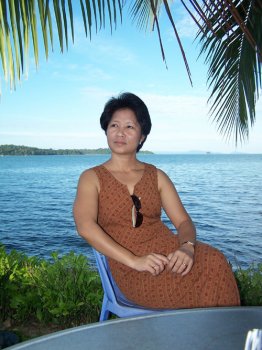
|
 |

|
 |
Sophiline C Shapiro: Taking initiative to infuse new energy into exquisite traditions - Lalitha Venkat December 4, 2008  Sophiline Cheam Shapiro is a choreographer, dancer, vocalist and educator whose original works have infused the venerable Cambodian classical form with new ideas and energy. Her choreography includes Samritechak (2000), The Glass Box (2002) and Seasons of Migration (2005), which she has set on Cambodia's finest performing artists and toured to three continents. Notable venues include Cal Performances, the Hong Kong Arts Festival, New York's Joyce Theater and the Venice Biennale. Her Pamina Devi had its world premiere at Vienna's New Crowned Hope Festival (2006) and toured the USA and Europe during the 2007-08 season. Her latest projects include Spiral XII with composer Chinary Ung for the Los Angeles Master Chorale, which premiered at Walt Disney Concert Hall in November 2008, and Shir Ha-Shirim, with composer John Zorn, for the Guggenheim Museum's Works & Process Series. Among her essays is 'Songs My Enemies Taught Me,' published in Children of Cambodia's Killing Fields: Memoirs by Survivors, compiled by Dith Pran, edited by Kim DePaul (1997, Yale University Press) and 'Cambodian Dance and the Individual Artist,' published in Dance, Human Rights & Social Justice: Dignity in Motion, edited by Naomi Jackson and Toni Shapiro-Phim (2008 Scarecrow Press). Cheam Shapiro has received numerous honors, including Asia21, COLA, Creative Capital, Durfee, Guggenheim and Irvine Dance Fellowships, as well as the 2006 Nikkei Asia Prize for Culture. She was the first Cambodian, first choreographer and youngest-ever recipient of this international award. Born in Phnom Penh in 1967, Cheam Shapiro was a child survivor of the Khmer Rouge "killing fields," during which she lost her father and brothers. She was a member of the first generation to enroll in and graduate from the [Royal] University of Fine Arts after the fall of Pol Pot's regime and was a member of the faculty there from 1988 to 1991. She studied all three major roles for women (neang, nearong and yeak), which is rare. With RUFA's ensemble, she toured India, the Soviet Union, the USA and Vietnam. She immigrated to Southern California in 1991, where she studied dance ethnology at UCLA on undergraduate and graduate levels. She now teaches and lectures internationally. Cheam Shapiro is the founding artistic director of Khmer Arts, which she established in 2002. The organization's programs include a community-based Academy in Long Beach, California, a professional touring Ensemble based in Takhmao, Cambodia, international Media projects, and a Research and Archiving initiative. Can you tell us about the performing arts tradition in Cambodia in connection with today's contemporary cultural milieu? Cambodia's performing arts traditions and dance in particular, trace their roots to the Angkorian Empire (9th to 15th centuries CE). The form, in which I work, classical dance, was born as a form of temple prayer, heavily influenced by Indian traditions, including that of the Devadasi. With the sacking of Angkor by the Thais and the move from Hinduism to Theravada Buddhism, classical dance became a court form and was maintained there for ritual and entertainment until 1970, when its practice was incorporated into the Faculty of Choreographic Arts at the University of Fine Arts. During the Khmer Rouge era (1975-1979), all forms of traditional arts were banned and artists, if discovered, were often killed. It is estimated that 90 percent of all professional artists perished in less than four years. In the years following "liberation," surviving dance masters eagerly trained a new generation of dancers to perpetuate the tradition. I was among that first post-Khmer Rouge generation to learn and perform classical dance. In recent years, many of the gains of the 1980s have been reversed by poor leadership, a crumbling infrastructure and the influences of tourism and global capitalism. The future of Cambodia's performing arts traditions may rest in the hands of independent groups and organizations, like my own, that are taking the initiative to infuse new energy and ideas into exquisite traditions. In Cambodia, how far have the many new and complex dimensions to the popular Ramayana epic been added, sometimes transforming the plot and characters...? As in many other Southeast Asian cultures, Cambodia has “Cambodianized” the Ramayana to reflect its aesthetics, religious beliefs and values. The Reamker, as it is called, features scenes and characters that are not present in Indian versions. Some of these unique scenes are the most popular among Cambodians. Also, I have found that some of the portrayals can strike Indians as somewhat shocking. For example, I once produced a Ramayana Festival in the USA that featured episodes performed by various South and Southeast Asian dance troupes. A Bharatanatyam dancer told me she was horrified by our Cambodian Hanuman, who in the Reamker is something of a womanizing flirt. How do the classical, medieval, and contemporary portrayals of Ramayana differ from each other in Cambodia? The Reamker, as it is danced, has changed little from era to era. Most changes have reflected the greater evolution of the dance form while the narrative has remained largely unchanged. How have the people made this Indian epic their very own? Here is an example of how I'm making this Indian epic my own: I am currently choreographing an episode from the Reamker regarding Reap's (Ravana's) earlier life. I am using this character's fall from grace to reflect how the perpetuation of violence leads to the failure of society. My interpretation is heavily influenced by my experience as a survivor of terror and genocide. In turn, that makes my interpretation very Cambodian. In short, what do international conferences on the Ramayana achieve? This epic narrative is something that a vast swath of humanity shares. In almost all South and Southeast Asian cultures, the Ramayana is a basis for dance, theater and puppetry. What we learn when we observe and interact with other interpretations and expressions is how local culture and history shapes the way we tell our stories, even when they originate elsewhere. Contact: e-mail: sophiline@khmerartsacademy.org |